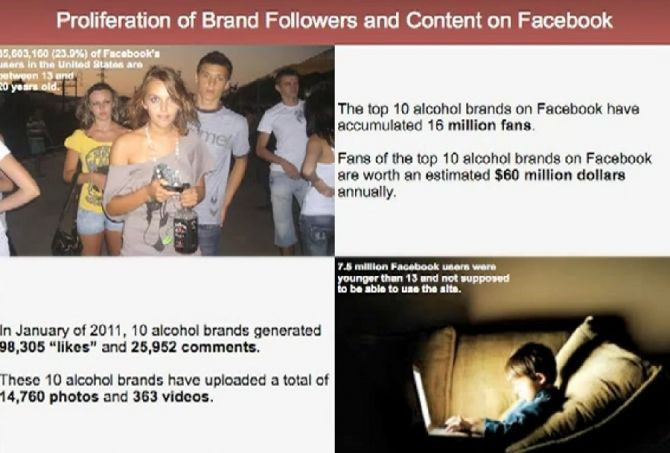Social Media Magnifies Exposure to Alcohol for Underage People

Underage people are endangered by the increasing exposure to the “alcohol experience” because of lax regulations for alcohol marketing on social media platforms such as Facebook, Youtube, and Twitter, a university watchdog group said Monday.
The Center on Alcohol Marketing and Youth (CAMY) published a new brochure and released a four-part Youtube movie that analyzes the alcohol industry’s push into digital marketing, and raises questions on whether the industry’s self- regulation is sufficient in protecting young Americans from drinking.
CAMY is a part of the Johns Hopkins Bloomberg School of Public Health.
The group’s analysis found that the top ten leading alcohol brands have more than 16.5 million people “liking” their Facebook brand pages as of November 2011, and these ten brands have uploaded 35,725 photos and 377 videos to their Facebook pages.
The brands also highly appeal to young people. Fans have taken the brands’ messages viral by uploading more than 15 thousand photos and nearly 100 videos to the alcohol brands’ Facebook pages.
Scrutiny on Industry Practices
Furthermore, images of Santa, toys, sexually suggestive photos, and those suggesting binge consumption of alcohol have flooded the industry’s social media sites, despite industry guidelines.
The center also tested the validity of the industry’s “age affirmation” technology that is supposed to prevent exposure of inappropriate marketing to underage youth, but says it found it essentially pointless because currently, a social media site user needs to state their age, but the age is not verified.
“Over and over again, youth are more likely to hear, read or see alcohol ads in mainstream media, and brands are now taking their messages from their branded sites to social media platforms such as YouTube, Flickr, Twitter, and Facebook," said David Jernigan, Director of the Center on Alcohol Marketing and Youth in a statement.
"As teens are early adopters of social media and there are viral elements of this media, parents need to be more aware of this marketing and to educate their children about the real harms of underage drinking in spite of the industry's message of glamour and allure," Jernigan added.
The center noted that in 2003, industry groups for beer and distilled spirits pledged to place alcohol ads in media venues only when underage youth makes up at most or less than 30 percent of the audience. CAMY says 14 longitudinal studies have shown that “the more young people are exposed to alcohol marketing, the more likely they are to start drinking or, if already drinking, to drink more.”
The CAMY brochure states that although the industry has reduced youth exposure in magazines and radio, youth exposure on television grew 71 percent between 2001 and 2009.
With the rapid expansion of digital media, more alcohol brands are swiftly moving toward the digital space to market their ads, and this raises concern according to CAMY.
According to Consumer Reports, more than 30 percent of minors on Facebook inflate their ages to sign up because Facebook does not permit users below the age of 13, and youth are overrepresented on Facebook in the United States.
While 13-20 year olds make up only 13.6 percent of the 13 and older population, as of October they made up nearly 22 percent of Facebook users.
Policy Implications
“The alcohol industry’s digital and social media marketing tactics are blurring the boundaries between advertising and content with unprecedented sophistication,” said Jeff Chester, the executive director for Center for Digital Democracy in a statement last year.
"The FTC and state attorneys-general should launch an investigation into this new threat to young people online," Chester added.
"Today's young people are living much of their lives online," said Kathryn Montgomery, a professor of communications at American University who co-authored an analysis, "Alcohol Marketing in the Digital Age" in 2010.
According to the National Center for Chronic Disease Prevention and Health Promotion, alcohol is used by more young people in the country than any other drug, and alcohol consumption is associated with approximately 75,000 deaths per year.
"With concerns about binge drinking and other dangerous behaviors among underage youth, public health professionals and policy makers must investigate these aggressive new alcohol marketing practices on social networks, mobile phone and other digital media so popular with children and teens," Montgomery said in the report.
Published by Medicaldaily.com



























